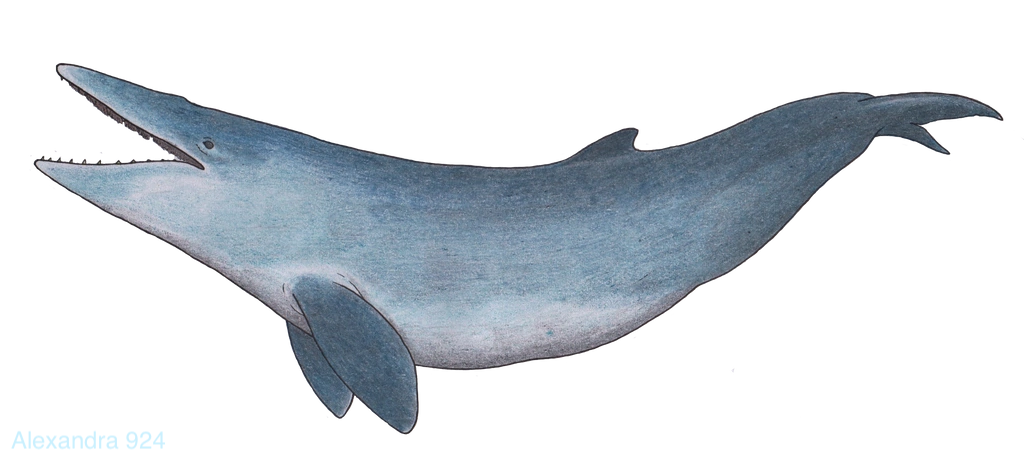Welcome to Aetiocetus

Name Definition
Original whale
Name Given By
A. cotylalveus/Douglas Emlong in 1966 ; A. polydentatus/Barnes, Kimura, Furuwasa, Sawamura in 1995 ; A. tomitai/Barnes, Kimura, Furuwasa, Sawamura in 1995 ; A. weltoni/Barnes, Kimura, Furuwasa, Sawamura in 1995
Location
A. cotylalveus was found in the Yaquina Formation of Oregon, U.S. ; A. tomitai has been found in the Morawan Formation of Japan ; other species were found in Mexico
Classification
Mammalia, Artiodactyla, Cetacea, Aetiocetidae
Size
5 - 6 meters long depending on the species
Temporal Range
Late Oligocene of the Paleogene period, ~34 - 23 million years ago
Ecological niche
large piscivore
Species/Sub Species
A. cotylalveus (type species), A. polydentatus, A. weltoni. A. tomitai
Diet
Aetiocetus’ bulk feeding strategy could target aquatic animals like fish and squids to eat
Introduction
Aetiocetus is an extinct genus of basal baleen whale or mysticete that lived in the northern Pacific Ocean around Japan, Oregon, and Mexico during the Oligocene. While Aetiocetus still does bear the incisors, canines, and molars like most other mammals, Aetiocetus also started to develop baleen (the brush-like structures in a filter feeding whale’s mouth), making it a good example of a transitional form between predatory whales and baleen whales, however, because baleen whales like the cetotheriids were contemporaneous with Aetiocetus, this makes Aetiocetus not the start of baleen whales. This means that true baleen whales would have evolved before Aetiocetus lived. Still, Aetiocetus’ descendants would be swimming in the oceans today. How do we know Aetiocetus has baleen? While baleen is a soft tissue and regularly does not preserve in the fossil record, palaeontologists who study whales can prove baleen attachment by examining the palates of the mysticete remains. This is most apparent in nutrient foramina. These nutrients are produced by superior alveolar artery nerve to the epithelial (surface cells of the animal’s body) so that baleen can grow from the palates. Now we come to what feeding strategies Aetiocetus uses. While the teeth are similar to those of archaeocetes (early and primitive whales) and odontocetes (toothed whales), the skull also possesses expanded palates for baleen. Most modern baleen whales use this baleen to trap small arthropods, plankton, and fish in their mouth and then consume them. This method is known as bulk feeding, and the whale chooses individual prey items instead of using echolocation like predatory whales and other piscivorous cetaceans. Because Aetiocetus has dentition similar to both categories of whales, it is down to the question whether Aetiocetus was a bulk-feeder or a carnivorous whale that incapacitated its prey with its teeth. If Aetiocetus did bulk feed and do selective prey capture, were they pre-adapting for the special feeding behavior of modern mysticetes? Aetiocetus has dentition similar to those of primitive odontocetes which have a method of bite and tear style of consumption and chew at a minimum. While all extinct and extant (living) odontocetes are known to find their prey through echolocation, there is no record of any mysticete whale using echolocation to find any prey in the fossil record. Piscivory ( a diet based on fish) is known as a primitive trait in the Cetacea infraorder, and it seems unlikely that Aetiocetus would have hunted like archaeocetes, locating fish without the use of echolocation. There is, however, another argument that Aetiocetus did use the bulk feeding method. It is stated that the theory views Aetiocetus as using a bulk feeder that gulps and strains prey in the water with their cusped cheek teeth. This is supported by the evidence of a loosely articulated jaw, and the wide palates. This feeding method is comparable to crab-eating seals. This hypothesis makes Aetiocetus as a bulk feeding whale while still retaining its teeth. This might mean that Aetiocetus was a functional mysticete. If this is true, then Aetiocetus would have been given cranial or mandibular kinesis (how much the skull bones can move in relative to one another), given the mysticete’s skull receives less strain exerted on the skull while bulk feeding. Erich Fitzgerald argued against this filter feeding with cusped teeth because of the lack of compressed teeth and the presence of postcanine crowns. Tom Deméré argues that this kind of filter feeding would have assumed very small prey like krill. However, the difference here is that Aetiocetus is a bulk feeder, not a filter feeder, and prey size does not matter when bulk feeding, based on the wide variety of animals extant mysticete whales consume. This means that Aetiocetus could target larger prey like squids and schooling fish.